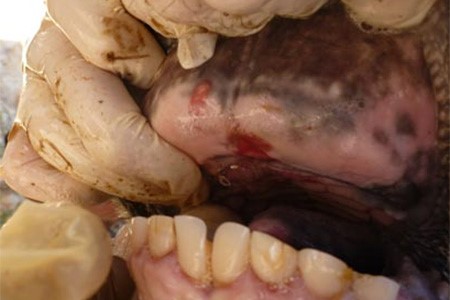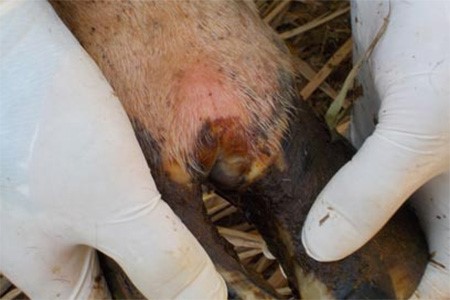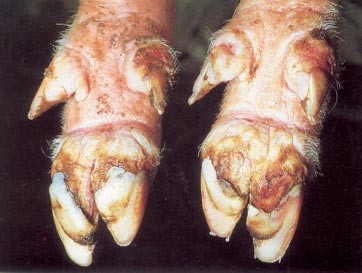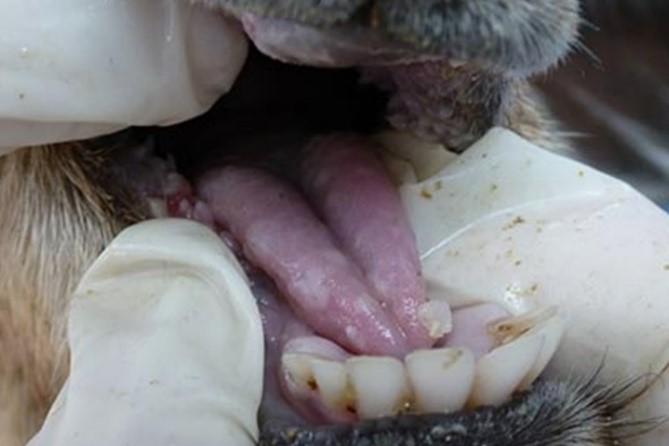Foot-and-mouth disease in animals
Help protect Australia
Foot-and-mouth disease (FMD) has been confirmed in countries close to Australia.
Northern Territory livestock owners should follow the advice below.
In the event of an outbreak early detection and reporting will be critical to rapidly contain this disease.
Report any unusual signs in animals by calling 1800 675 888.
Foot-and-mouth disease (FMD) is a highly contagious viral infection of cloven-hooved animals (the hooves are divided into 2 parts).
This includes cattle, buffalo, pigs, goats, sheep and deer.
An outbreak of FMD in Australia could have devastating consequences for livestock industries and the wider community.
It is not a threat to human health or related to human hand, food and mouth disease. It can't be passed on to people through meat.
FMD is caused by a picornavirus. Worldwide, there are 7 distinct serotypes of FMD virus: O, A, C, SAT 1, SAT 2, SAT 3 and Asia 1.
Responsibilities
Read the information below to find out what you should do.
Travellers
Never bring any meat or animal products back into Australia if you’ve been travelling overseas.
If you have been hiking, or visiting farms or rural areas overseas you must declare this on entry to Australia.
Clothing and equipment such as hiking gear that has been in contact with animals, animal waste or soil must be carefully cleaned and disinfected. This is because the virus can survive in particles of soil.
Carrying infectious virus on the soles of shoes, walking sticks etc, could lead to infection of animals in Australia.
If you may have been in contact with FMD-infected animals, you should not visit any property with livestock for at least 7 days after returning to Australia.
Livestock owners
Learn to recognise the signs of FMD and monitor your animals closely.
You should prevent:
- visitors from having unnecessary contact with your livestock
- contact between domestic and feral pigs.
Check for signs
You must call the emergency animal disease (EAD) hotline immediately on 1800 675 888 if you have any young animals:
- that die suddenly or
- you suspect one of your animals may have blisters (formed or ruptured).
Get a property identification code
You must register a property identification code (PIC). It is free and can be done online.
The PIC system allows animals to be easily traced if an animal disease outbreak takes place.
Complete a waybill if you move livestock
If you plan to move livestock, you must complete an NT waybill.
This is an official record of livestock movement which allows a biosecurity response team to track animals if an outbreak happens.
Feeding pigs
Only feed fruit, vegetables, grains and commercial livestock feed to pigs.
Never feed prohibited feed (swill) such as kitchen scraps to pigs as it can introduce FMD and other serious animal diseases.
Keep pigs out of dumps.
Property biosecurity plan
Have a property biosecurity plan in place. Make sure all workers and visitors are aware of your biosecurity rules.
This may include not allowing anyone who has been overseas to come onto your property for 7 days after arriving back into Australia.
Practise good hygiene
Ensure items and equipment coming on to or leaving your property are clean.
Wear clean clothes and footwear when visiting a property
Vets
Read the emergency animal diseases - a field guide for Australian veterinarians on the Australian Government's Outbreak website.
Get information on FMD clinical signs, sampling and testing.
Find out more about what to look out for on the Australian Government's Department of Agriculture, Fisheries and Forestry website (DAFF) and World Organisation for Animal Health (OIE) websites.
Get the FMD guide for veterinarians on the Queensland Government website. You can also watch the YouTube videos on biosecure entry and exit decontamination.
Hunters
Always practise good biosecurity when you're out hunting by:
- cleaning and disinfecting all clothing, equipment and vehicles on site
- reporting any unusual signs in animals by calling the emergency animal disease hotline on 1800 675 888
- respecting all quarantines and restrictions that are in place
- not moving live animals to new locations
- taking your rubbish home – food scraps may be eaten by animals, which is a potential form of swill feeding.
Signs
The disease can look slightly different in different species. In all species, very young animals may die.
Cattle and buffalo
- Lethargic and reluctant to walk
- Drooling
- Blisters or ruptured blisters:
- in the mouth and on the tongue
- on the teats of females
- between the toes and around the top of the hoof
- Rapid weight loss
- Signs in buffalo might not be as severe.

Mouth blister. Photo credit Agriculture Victoria.

Foot blister. Photo credit Agriculture Victoria.
Pigs
- Lameness - pigs may appear to want to crawl instead of walk due to painful hooves.
- Blisters on the feet or blanched (white) looking skin around the hoof.
- In severe cases the hoof may appear to be detaching from the toes.
- Blisters on the snout.

Pig’s feet with 9-day old blisters. Photo credit Biosecurity Queensland.
Sheep and goats
- Signs of FMD in sheep and goats are usually very mild and may be easily missed.
- Common signs can include a fever and lameness in one or more legs.
- Blisters may form in the mouth but are not as noticeable as in cattle.

Tongue blister. Photo credit Agriculture Victoria.
Where it's found
FMD is found in the Middle East, African, Asian and South America.
It has not occurred in Australia since 1872.
In May 2022, an outbreak of FMD was reported in cattle in Indonesia.
International outbreaks are a reminder that animal diseases can spread quickly and do not respect international borders.
How it's spread
FMD is one of the most contagious animal diseases.
Infected animals excrete the virus in fluid from:
- ruptured blisters
- exhaled air
- saliva
- milk
- semen
- faeces
- urine.
Virus transmission
Virus transmission can begin before blisters appear. Some animals can carry the virus for long periods (months or years) after apparent recovery.
The primary method of transmission within herds and flocks is by direct contact or via respiratory particles and droplets.
Pigs are known to produce a lot of the virus when infected, and are a high risk of spreading FMD to other animals.
Infection can spread between properties due to movement of infected animals or contaminated vehicles, equipment, people and products.
Windborne spread of infected aerosols can occur under the right conditions.
FMD virus may remain infective in the environment for several weeks to months in organic matter such as:
- soil
- manure
- dried animal secretions
- straw
- hair
- leather.
FMD virus can also survive in meat and dairy products.
The most likely way FMD could enter Australia is via the illegal importation of contaminated products from overseas.
Monitoring and action
Suspect cases of FMD must be immediately investigated by a veterinarian or livestock biosecurity officer.
Where appropriate, samples of vesicular (blister) fluid, epithelial tags and blood should be collected and sent to the Berrimah Veterinary Laboratory for diagnostic purposes.
Impact
FMD is considered one of Australia's greatest biosecurity risks.
An FMD incursion would have severe consequences for Australia's animal health and trade, including considerable economic losses with restrictions being placed on both domestic and international markets.
Even an isolated, rapidly controlled outbreak could cost several billion dollars to eradicate, with serious economic and social effects in other sectors, including tourism.
Impacts would be felt across the live animal export trade, and by exporters of genetic materials, meat and dairy products.
A large multi-state FMD incident could cost Australia more than $52 billion in lost revenue over 10 years.
Spread
FMD is a viral disease that spreads rapidly between animals.
The virus is excreted in breath, saliva, mucus, milk and faeces.
Animals can become infected through direct contact with:
- infected animals or materials
- eating or drinking infected products
- breathing in the virus.
The disease spreads most commonly through the movement of infected animals.
Pigs can be infected with FMD through swill feeding. This is when pigs are fed uncooked meat or unprocessed dairy products, including those that might have been illegally imported from FMD-affected countries.
Swill feeding is illegal in Australia.
Pigs produce large amounts of infectious virus in the breath, so they can infect many other animals.
Cattle are very susceptible to, and able to be infected by breathing in small quantities of the virus.
FMD-infected feral pigs could be a major source of disease for NT pastoral properties. They can shed the virus around water points and other places where cattle encounter pigs and pig waste products.
Control
If FMD was detected in Australia, the disease would be contained and eradicated as quickly as possible in order to reinstate Australia's disease-free status for trade purposes.
The eradication program will be delivered according to the AUSVETPLAN response strategy for FMD.
Measures to eradicate the FMD outbreak would include:
- strict movement controls, including an immediate livestock standstill
- tracing the movements of animals, animal products, people and things to identify where infection has spread
- surveillance to detect infected herds and flocks
- the humane slaughter and biosecure disposal of infected herds and flocks
- decontamination to destroy the virus
- other movement controls and enhanced biosecurity to minimise spread of disease.
Emergency livestock vaccination may, in certain circumstances, be an important part of controlling an FMD outbreak.
Australia will consider the potential for emergency vaccination of livestock as part of the response strategy from the day an incursion of FMD is detected.
How to report
If you notice anything unusual or suspicious, call:
- the emergency animal disease watch hotline on 1800 675 888
- your local vet or livestock biosecurity officer.
Alerts and updates
For biosecurity alerts and updates, go to the Agriculture NT Facebook page.
More information
Read the prohibited pig feed: don’t feed swill to pigs PDF (160.8 KB).
Find out more on the Queensland Government's Business website about:
- foot-and-mouth disease awareness training for livestock owners
- foot-and-mouth disease online training for veterinarians and veterinary paraprofessionals.
Read about FMD and the Australian Government's response on the DAFF website.
Find out more on the Australian Government Department of Agriculture, Fisheries and Forestry website about:
For information about biosecurity plans, go to the Farm Biosecurity website.
Contact
Contact your local vet or livestock biosecurity officer.
Give feedback about this page.
Share this page:
URL copied!